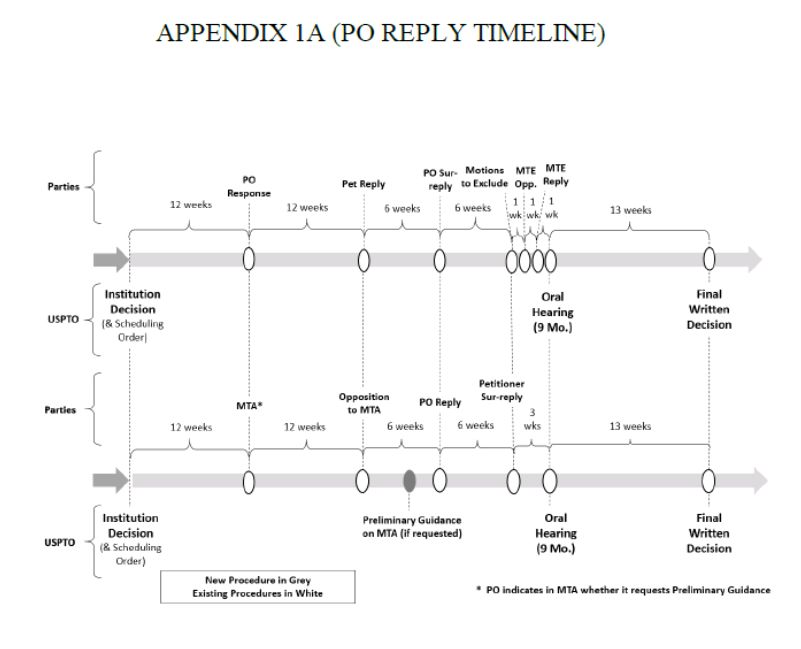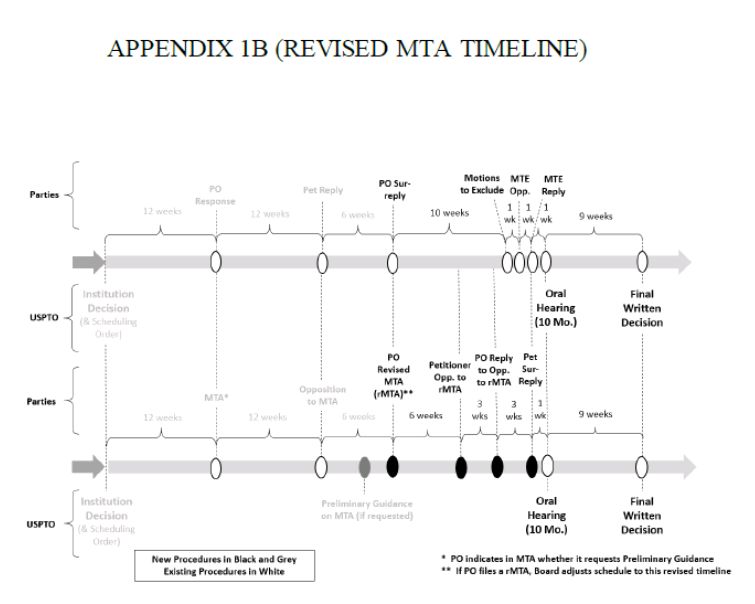Today, the USPTO released its long-awaited "Notice Regarding a New Pilot Program Concerning Motion to Amend Practice and Procedures in Trial Proceedings Under the America Invents Act Before the Patent Trial and Appeal Board" ("Notice"). The Notice is a 36-page document warranting close scrutiny for the changes it potentially introduces into post-grant proceedings, some of which are outlined below. The new pilot program for Motions to Amend ("MTA") will apply to all AIA trial proceedings instituted on or after March 15, 2019 (i.e., formal publication of the Notice in the Federal Register).
New MTA Options for Patent Owners
The pilot program introduces two options not previously available: "The first option is that a patent owner may choose to receive preliminary guidance from the Board on its MTA. The second option is that a patent owner may choose to file a revised MTA after receiving petitioner's opposition to the original MTA and/or after receiving the Board's preliminary guidance (if requested)." Notice at 3. The schedule of proceedings is modified depending on the options selected by the Patent Owner, with generally "more time to prepare filings and evidence." Notice at 22-23.
There had been concern following the USPTO's initial Request for Comment of October 29, 2018 ("RFC") that the changes envisioned for MTA practice might be mandatory for all parties seeking claim amendments in post-grant trial proceedings, lacking any ability to "opt-out" as might be expected of a true "pilot" program. However, responding to this criticism, today's Notice makes clear that "a patent owner who files an MTA will have the ability to choose how that motion will proceed before the Board." Notice at 2.
As part of the pilot program, the Patent Owner now has new options to pursue in step-wise fashion, as desired. These choices for MTA procedure range from the current submission and review path for MTAs (with only minor scheduling changes); to the possibility of adding one or both of a Request for Preliminary Guidance on the MTA and/or submission of a Revised MTA and subsequent briefing. These options are briefly summarized below:
- Pursue Current MTA Practice: Even if qualifying for the "pilot" program based on institution date, the patent owner will, if desired, still "be able to pursue an MTA in effectively the same way as current practice," including, for the most part, "the timing of due dates for already existing papers in an AIA trial." Notice at 3. One timing exception is that some due dates for later-filed MTA replies and sur-replies will be extended to six weeks; in addition, "a patent owner will have 6 weeks to file a sur-reply after receiving a reply in relation to the petition, regardless of whether patent owner files an MTA." Notice at 3. Consistent with known statutory and regulatory requirements, "an MTA must, among other things: propose a reasonable number of substitute claims; propose substitute claims that do not enlarge the scope of the claims of the challenged patent or introduce new subject matter; respond to a ground of unpatentability involved in the trial; and set forth written description support for each substitute claim." Notice at 14 (citing 35 U.S.C. §§ 316(d), 326(d); 37 C.F.R. §§ 42.121, 42.221; Lectrosonics, Inc. Zaxcom, Inc., Case IPR2018-01129 (PTAB Feb. 25, 2019) (Paper 15) (precedential)). Pursuant to current regulations, a patent owner must still confer with the Board before filing any MTA. Notice at 6-7.
- Request that the Board to Issue Preliminary Guidance on the Proposed Amended Claims: If the patent owner files an MTA, it may request therein an initial assessment of the proposed amendments by the Board. Notice at 13-16. This would be offered after the deadline for the petitioner to file its Opposition to the MTA (if desired), so the Board can assess arguments from both sides concerning the likelihood of meeting regulatory and statutory requirements for the amendment. If this option is selected, "The Board's preliminary guidance will focus on the limitations added in the patent owner's MTA, and will not address the patentability of the originally challenged claims." Notice at 4. Typically, the Board's guidance at this point will issue in a non-binding "short paper," or possibly oral guidance by phone conference. Notice at 4, 11, 29. "Although preliminary guidance will not be binding on the Board's subsequent decisions or provide dispositive conclusions regarding MTA requirements or the patentability of substitute claims, it may provide information helpful to the parties." Notice at 15. In response to Petitioner's Opposition to the MTA and/or the Board's Preliminary guidance (if requested), patent owner may take one of the following actions: simply reply to Petitioner's Opposition to the MTA and/or the Preliminary Guidance (if requested); or file a Revised MTA (see below); or take no action and file no paper regarding the MTA on the due date for Patent Owner's Reply or a Revised MTA after the Board issues preliminary guidance (if requested). Notice at 12.
- File a Revised MTA and Subsequent Briefing: In response to Petitioner's Opposition to the MTA and/or the Board's Preliminary Guidance (if requested), patent owner may next choose to file a Revised MTA. Id.; id. at 15 ("following the petitioner's opposition to the MTA and/or based on the Board's preliminary guidance (if requested), the patent owner may choose to file a reply to the opposition to the MTA and/or preliminary guidance, file a revised MTA, or do nothing"). According to the Notice: "A revised MTA includes one or more new proposed substitute claims in place of previously presented substitute claims to address issues identified in the preliminary guidance and/or the petitioner's opposition." Notice at 12. A Revised MTA may include substitute claims, arguments, or evidence previously presented in the original MTA, but may not incorporate any material by reference from the original MTA. Notice at 5. While the Revised MTA may presumptively advance "only one substitute claim to replace each of the original substitute claims" and provide new "arguments, and/or evidence" in support thereof, it should be remembered that the revised MTA may not include matter "unrelated to issues raised in the preliminary guidance and/or petitioner's opposition to the MTA." Notice at 12. Further briefing follows the submission of a Revised MTA, submitted on a new schedule issued by the Board, including an oral hearing within 10 months after the institution decision. Notice at 5, 19; but see id. at 16 ("If patent owner chooses to file a reply, rather than a revised MTA, the oral hearing will typically be conducted approximately 9 months after the institution decision, as in the Board's current practice.").
Timing and Schedule
Even with parties opting for the all new MTA procedures in the Notice, the Board still anticipates completing the entire trial proceeding within the 12-month statutory deadline, with any case-by-case extensions granted only for good cause. Notice at 19 ("the Board will typically issue its final written decision in accordance with the statutory deadline"). The new procedures can be complicated and deadlines must be researched fully; the Notice provides in-depth treatment, including the following graphics detailing the timing of the various options:


Several other important points are made in the Notice:
- Burden of Persuasion: The Notice states that "[t]he preliminary guidance also will provide an initial discussion about whether petitioner . . . establishes a reasonable likelihood that the substitute claims are unpatentable." Notice at 4 (emphases added).
- Examiner Assistance: In the event that a petitioner does not continue in the case, "the Board may, in its discretion, solicit patent examiner assistance regarding the MTA." Notice at 20. "If solicited by the Board, the assistance, e.g., by an examiner in the Central Reexamination Unit ("CRU"), could include the preparation of an advisory report . . . ." Id.
- New Evidence and Depositions: New evidence and declarations may typically accompany oppositions and replies (but not sur-replies). See Notice at 15 ("Generally speaking, new evidence (including declarations) may be submitted with every paper in the MTA process, except a sur-reply."). Thus, depositions occurring later than typical in current proceedings may be required under the pilot program—the USPTO urges party cooperation to timely conduct any necessary depositions. Notice at 19 ("As discussed above, once the likely declarants are known, the parties should confer as to dates for scheduling depositions after the relevant papers are filed. Parties are expected to make their declarants, and their attorneys, available for such depositions promptly . . . .").
- Contingent or Non-contingent: Similar to present practice, and despite debate around the subject, the patent owner's MTA may be made "contingent on the unpatentability of the original claims or may be non-contingent. . . . If the MTA is contingent, the final written decision addresses substitute claims only if corresponding original claims are found unpatentable." Notice at 7; id. at 32.
- Duration: The USPTO states that this "pilot" program will be in effect for about one year, as a test period and to gain insight on the effectiveness of the program. It may be terminated or continued, depending on the results. Further, the USPTO invites comments to be made during the pilot to the extent a problem arises.
Director Iancu has repeatedly stated that he desires to give patent owners a more robust ability to amend claims during an AIA trial. This pilot program attempts to take steps in that direction by enabling patent owners to receive valuable feedback from the PTAB on proposed amendments and the ability to improve the proposed substitute claims in view of that feedback.
The content of this article is intended to provide a general guide to the subject matter. Specialist advice should be sought about your specific circumstances.
[View Source]
